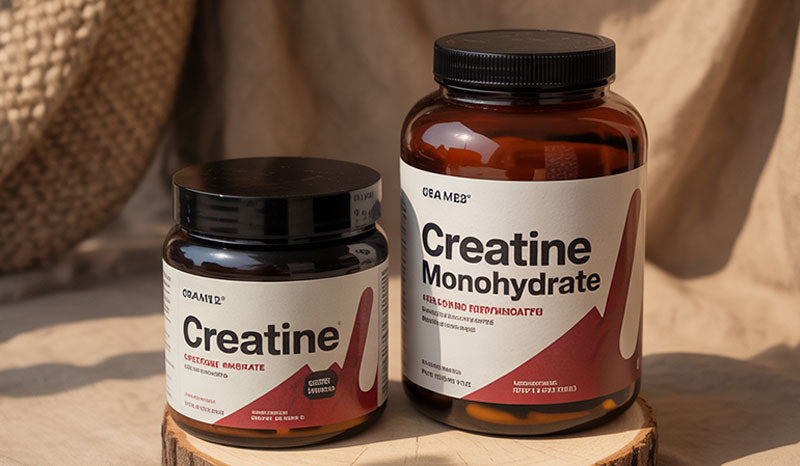Difference Between Creatine and Creatine Monohydrate
Creatine - When it comes to supplements in the fitness world, creatine is one of the most researched and widely used compounds.
However, a common point of confusion among fitness enthusiasts, especially in India, is the difference between “creatine” and “creatine monohydrate.”
While the terms are often used interchangeably, there are subtle distinctions that can impact your fitness goals, effectiveness, and budget.
Creatine: What It Is?
Creatine is a naturally occurring compound found in small amounts in foods like meat and fish.
It is also synthesized by the human body, primarily in the liver, kidneys, and pancreas, from amino acids such as arginine, glycine, and methionine.
In essence, creatine serves as a quick energy source for your muscles.
During high-intensity activities such as sprinting, weightlifting, or HIIT workouts, your muscles rely on adenosine triphosphate (ATP) for energy.
Creatine helps replenish ATP rapidly, allowing you to sustain performance, lift heavier, and recover faster.
What is Creatine Monohydrate?
Creatine monohydrate is the most common and researched form of creatine supplement available on the market.
It consists of a creatine molecule attached to a single water molecule, which increases its stability and ease of absorption in the body.
Studies have consistently shown that creatine monohydrate improves strength, enhances lean muscle mass, and boosts exercise performance.
It is also widely considered safe when taken at recommended doses, making it the go-to choice for both beginners and professional athletes.
Creatine and Creatine Monohydrate
Creatine is the compound itself, while creatine monohydrate is its most common, stable, and well-researched supplement form.
| Point | Creatine | Creatine Monohydrate |
|---|---|---|
| Definition | General compound naturally found in body and foods | Specific, most common form of creatine attached to a water molecule |
| Chemical Structure | Pure creatine molecule | Creatine + 1 water molecule (monohydrate) |
| Absorption | Depends on the form | Easily absorbed and highly bioavailable |
| Performance Benefits | Improves strength, energy, and muscle growth | Proven to enhance strength, power, recovery, and muscle mass |
| Safety | Generally safe, but depends on the form | Well-researched, safe for most people at recommended doses |
| Side Effects | Varies with type | Mild bloating or digestive discomfort possible |
| Cost & Availability | Can vary; some forms expensive or less available | Affordable, widely available in India and globally |
Differences in Chemical Structure
At a molecular level, “creatine” refers to the compound itself, while “creatine monohydrate” refers to a specific form of creatine.
The key difference is the water molecule attached to the creatine in creatine monohydrate.
This seemingly minor difference affects:
-
Absorption Rate: Creatine monohydrate dissolves in water, making it easier for the body to absorb.
-
Stability: It remains stable under normal storage conditions, whereas other forms of creatine may degrade more quickly.
-
Purity and Cost: Creatine monohydrate is often cheaper and widely available due to its simplicity and long-standing presence in the market.
Performance Benefits: Are There Differences?
One of the biggest questions fitness enthusiasts ask is whether one form is superior to the other in terms of results.
The truth is: for most people, creatine monohydrate delivers the same performance benefits as any other form of creatine.
These benefits include:
-
Increased Strength and Power: Helps improve your one-rep max and overall lifting capacity.
-
Muscle Growth: Promotes water retention in muscle cells, enhancing cell volumization and muscle size.
-
Enhanced Recovery: Reduces muscle damage and inflammation after intense workouts.
-
Cognitive Benefits: Emerging studies suggest creatine may support brain health and mental performance.
Safety and Side Effects
Creatine monohydrate has a long track record of safety. Decades of research and clinical trials confirm that, when used responsibly, it poses minimal risk for healthy individuals.
Common side effects may include:
-
Mild bloating due to water retention
-
Temporary digestive discomfort if taken in very high doses
It’s important to note that “creatine” as a general term can include newer or less studied forms, some of which may have different tolerability profiles.
Therefore, opting for creatine monohydrate is often the safest and most reliable choice, especially in India, where regulatory oversight for supplements may vary.
Usage and Dosage
Understanding how to use creatine properly is crucial for maximizing its benefits.
Creatine Monohydrate Dosage Guidelines:
-
Loading Phase (Optional): 20 grams per day split into 4 doses for 5–7 days.
-
Maintenance Phase: 3–5 grams per day.
-
Timing: Post-workout with carbs or protein can improve absorption, but timing is flexible.
For general “creatine” supplements, always check the label for the form and purity. Some blends may contain other compounds, which can alter the effective dosage.
In India, powdered creatine monohydrate is more common than capsules due to cost-effectiveness and flexibility in dosing.
Which One Should You Choose?
So, which should you pick: creatine in general or creatine monohydrate?
Here’s a simple breakdown:
-
Creatine Monohydrate: Best for beginners and most athletes. Proven, affordable, safe, and effective.
-
Other Creatine Forms: May offer marketing claims like faster absorption, but real-world benefits are similar to monohydrate. Could be useful if you experience digestive issues with monohydrate.
Conclusion
Understanding the difference between creatine and creatine monohydrate doesn’t have to be confusing.
While “creatine” is the compound itself, creatine monohydrate is the specific, most-studied form of that compound.
For the vast majority of fitness enthusiasts, creatine monohydrate offers a combination of safety, affordability, and proven performance benefits.
Whether your goal is to build lean muscle, increase strength, or improve recovery, incorporating creatine monohydrate into your routine can be a game-changer.
In India, where supplement options continue to grow, making an informed choice ensures that your money, effort, and workouts pay off.
By understanding these differences, you can confidently select the right supplement, optimize your performance, and achieve the results you want without getting lost in marketing claims or complex jargon.
.
.
.


